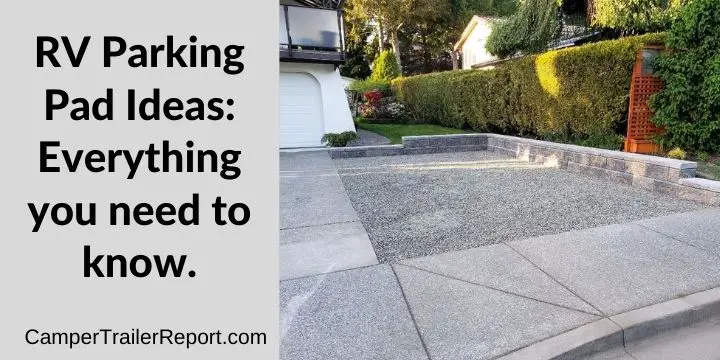RV Parking Pad Ideas: Everything you need to know.
Parking your RV at home when you aren’t traveling can be a great and affordable solution. You will save on the storage costs and also use it while it is there. But, remember, it must be parked in a proper place to prevent any damages.
The parking pad should be good to keep the RV from being destroyed by water. Besides, the ground should be strong enough to handle its weight.
Have you been wondering about the RV parking pad ideas to park your RV while at home? Keep reading to find out. But, let’s first talk about the RV pad basics.
What is an RV pad?
An RV pad is a place where the RV can be parked. It can be made of gravel, concrete, mesh, or permeable pavers. RV pad mainly prevents your RV tires from getting damaged. The parking pad must be strong to handle the weight of the RV.
> You may also like:45 RV Accessory Must-Haves for Your Travel Trailer<<
How Much Does it Cost to Build an RV Pad?
The cost of building an RV pad depends on whether you are building it yourself or using the help of professionals. There are water hookups costs and electrical hookups costs. If you hire a plumber, the cost may be approximately $750 and $1200 if you hire an electrician.
How do you Make an RV Parking Pad?
Making an RV parking pad is not a walk in the park. It requires labor and some skills. Here are the steps for making an RV parking pad;
Step 1:
Prepare the place and dig out the dirt to flatten the place.
Step 2:
Build a retaining wall! First, dig a small trench of 1 or 2 inches deep. Level the place with sand. Use a laser level to ensure the wall is perfectly flat and straight.
Step 3:
Add landscaping fabric at the bottom of the RV pad.
Step 4:
Level the place and add leveling sand.
Step 5:
Fill the place with gravel.
Step 6:
Add retaining wall caps to the top edges of the retaining wall.
Step 7:
Finish the end of the wall, and prepare for building a gate/fence.
Step 8:
Install a fence with a gate
Video Overview: I Built My Own RV Pad!
How Deep Should an RV Gravel Pad be?
An RV gravel pad should be at least 6 to 8 inches. The large base stones must be installed at the bottom up to 4 to 6 inches to make it strong.
> You may also like:Worst 5th Wheel Brands to Avoid <<
5 Best RV Parking Pad Ideas:
We all know that the RV parking pad should be strong and durable. Here are ideas you can use to get a good parking pad;
1. Permeable Pavers
The permeable pavers have open cells filled with grass to help water go through the surface, which is then drained in the base. The drained water will then be absorbed into the ground.
The pavers are porous, leading to better water draining. The water drainage mainly depends on the material used to make the paving system. These systems are quite strong and resilient, thus good for the RV pad.
2. Vapor Barrier on the Grass
If you park your RV on grass; there is the possibility of insects and other animals climbing into your RV. Moreover, the tires can get destroyed due to moisture. Grass does retain dirt and water, exposing your RV tires to moisture, hence decreasing their longevity eventually. Therefore, including a vapor barrier in between the ground is ideal.
> You may also like: 25 Best National Parks in the USA <<
3. Gravel
Using gravel or crushed rocks is also a cost-effective way to make an RV parking pad. Both gravel and rocks do not damage the tires since they enable water to drain and dissipate. Ensure that you know the soil conditions to install the gravel pad. It will help it last for some time. It is important to use a depth of 8 inches when making a gravel pad.
Video Overview: RV TRAILER? How to build a Gravel parking pad in 4 EASY steps!
4. Concrete pad
You can also consider using concrete for making an RV parking pad. But, the concrete pad needs to have a separate water draining system. This will make the water drain and not affect the tires. Such a pad is easier to clean, durable and you can move the RV easily.
Video Overview: Making a small concrete pad, no fancy tools. ASMR
5. Putting Mesh on Grass
The mesh is made of synthetic material and can be rolled over grass. It is made to support RV weight and also preserve the grass below. It is less costly and also can serve you for some time. However, ensure that you ask for weight limits for such parking mats from a professional.
So, after going through these ideas, are you still confused about the best material for your Rv pad? Don’t be. Know your prerequisites, and budget and you are good to find the best option.
> You may also like: Least-Visited National Parks: Why They’re Worth a Look<<
